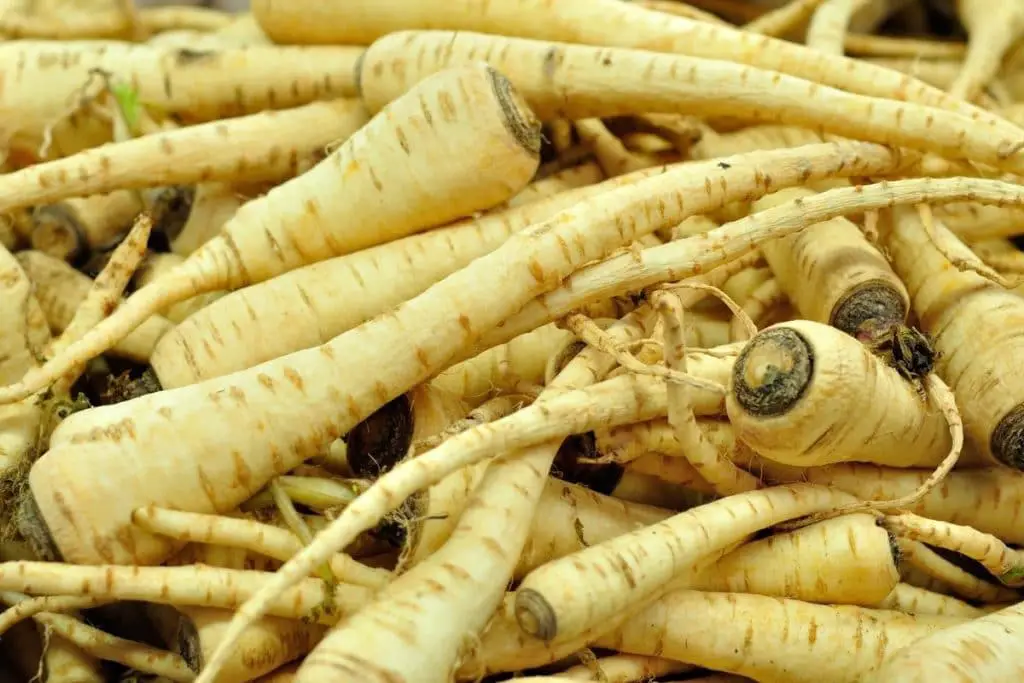In short, the best alternatives to parsnips are parsley root, carrots, turnips, salsify, etc. Each alternative offers a slightly different flavor profile and texture but can be used in similar dishes and preparations.
Parsnips are a winter vegetable with great health benefits. Except for their white color, parsnips look just like carrots and can be cooked in similar ways.
Parsnips can be sliced, grated, or roasted whole and are often used in soups and stews, casseroles, and other hearty warm dishes.
Parsnips aren’t always in season and can be hard to find depending on the area you live in. If your recipe calls for parsnips, and you can’t find any or don’t particularly like the taste, there are a bunch of other delicious veggies you can use as a substitute for parsnips.
Here is your guide to the best substitutes for parsnips in deliciously hearty savory dishes.
How To Use Parsnips
Parsnips are versatile vegetables that can be baked, boiled, roasted, pureed, steamed, fried, or grilled. They give a rich flavor to soups, stews, and casseroles. In some cases, they are boiled in the dish to facilitate thickening and add flavor and are then removed before serving.
Roast parsnips are a traditional part of Sunday roast and Christmas dinners. They can also be thinly sliced and deep-fried to make crisps. A lesser-known use for parsnips is that they can be made into wine that tastes similar to Madeira.
Best Parsnip Substitutes
1. Parsley Root
Parsley roots are similar to parsnips in appearance. Parsley root is a good substitute for making puree, adding to mash or soup. It will successfully mimic the starchy texture of parsnip but is sweeter and milder in taste. It can be prepared, baked, roasted, or fried. Unlike parsnips, parsley root can also be eaten raw in a salad.
Parsley root is not commonly sold in all grocery stores and is more likely to be found at local farmer markets.
2. Carrots
Although known mostly to be bright orange in color, carrots also come in purple, white, and yellow varieties. Carrots have a similar shape and crunchy texture to parsnips when raw, although they lack the hint of spiciness and have a slightly sweet taste.
Despite the big difference in color, orange carrots are a great option to replace parsnip as a side dish, roasted, steamed, added to stews and casseroles, or sauteed with other vegetables.
3. Turnips
Turnips are a winter root vegetable with a flavor similar to that of cabbage and radish mixed. Its crispy white flesh has a mild, peppery flavor. When replacing parsnips with turnip, choose succulent young vegetables that have not yet developed a bitter taste.
Turnips are ideally mashed, roasted, steamed, or chopped into stir-fry. To make up for their lack of sweetness, you can drizzle or coat them with a sweet sauce, such as a honey glaze.
4. Salsify
Salsify, also sometimes referred to as an oyster plant, is more popular in Europe than in the United States. The root vegetable looks almost like a tree branch with a cylindrical brown exterior and white flesh.
To prepare, boil it and then peel the exterior brown skin after cooking. Use it in soups and stews, mash the flesh with butter, or serve with a creamy white sauce.
5. Arracacha
Also known as a Peruvian parsnip, arracacha is a perennial vegetable of South American regions with high rainfall and a warm climate. When cooked it has a slightly sweet and nutty taste resembling a mix of cabbage, celery, and roasted chestnuts.
Like parsnips, arracacha is only eaten cooked and can be boiled, fried, or baked. It can be served as a side dish roasted, pureed, or used as a filling in gnocchi, pastries, and dumplings.
6. Celeriac
Celeriac or celery root is a light brown and white colored round root vegetable with an earthy flavor.
Although it does not taste like parsnip it can still be used as a substitute in many recipes. It can be boiled, braised, roasted, and used in making soups, purées, and stews. Celeriac needs a slightly longer cooking time than parsnips.
7. Sweet Potato
Even though sweet potatoes are winter vegetables, they are easily accessible year-round. With a slightly softer texture than parsnips, they don’t need to be cooked for quite as long.
They make a great sweet starchy alternative especially when baked and roasted, but can also be mashed, pureed, and added to stews and casseroles.
If taro root is more accessible to you than sweet potato, it can be used equally well to replace parsnips.
8. Kohlrabi
If you are trying to use up what’s in your pantry and have some older kohlrabi that you don’t know what to do with, it will make a good substitution for parsnips.
When kohlrabi gets older, it loses some sweetness and develops a slightly stronger flavor. Use it in meat or vegetable soups, allowing it to soften as it boils with the other ingredients.
9. Potato
Regular potatoes are neutral in flavor, and while they are not the closest substitute for parsnips, they can be used successfully. Add some extra seasoning to amp up the flavor when using potatoes as a replacement.
The great thing about potatoes is that they are incredibly versatile and go with any dish. They can be boiled, roasted, fried, mashed, added to stews, soups, casseroles, and served as a side dish to roast beef or other meat dishes.
They can be manipulated to match different flavor profiles depending on the seasonings you use.
10. Radish
Radishes have a strong spicy flavor. They are generally eaten raw in salads, but can also be roasted or used in a stir-fry as a parsnip substitute.
FAQs
Conclusion
Parsnips closely resemble white carrots in their appearance, although they have a slightly sweeter taste when cooked. They are a great addition to warming winter dishes.
If you don’t have parsnips on hand, most other root vegetables can be used instead. For similar flavor, color and texture use parsley root, celery root, turnips, white or yellow carrots.
If you already have sweet potatoes or potatoes in the pantry, use them as an easy alternative. Whichever option you choose, make sure your veggies are cooked through and enjoy nutritious and delicious, comforting goodness.
*image by mihai_tamasila/depositphotos









